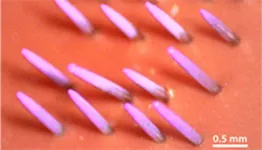(Press-News.org) Rutgers scientists have devised a highly accurate method for creating coatings of biologically active materials for a variety of medical products. Such a technique could pave the way for a new era of transdermal medication, including shot-free vaccinations, the researchers said.
Writing in Nature Communications, researchers described a new approach to electrospray deposition, an industrial spray-coating process. Essentially, Rutgers scientists developed a way to better control the target region within a spray zone as well as the electrical properties of microscopic particles that are being deposited. The greater command of those two properties means that more of the spray is likely to hit its microscopic target.
In electrospray deposition, manufacturers apply a high voltage to a flowing liquid, such as a biopharmaceutical, converting it into fine particles. Each of those droplets evaporates as it travels to a target area, depositing a solid precipitate from the original solution.
“While many people think of electrospray deposition as an efficient method, applying it normally does not work for targets that are smaller than the spray, such as the microneedle arrays in transdermal patches,” said Jonathan Singer, an associate professor in the Department of Mechanical and Aerospace Engineering in the Rutgers School of Engineering and an author on the study. “Present methods only achieve about 40 percent efficiency. However, through advanced engineering techniques we’ve developed, we can achieve efficiencies statistically indistinguishable from 100 percent.”
Coatings are increasingly critical for a variety of medical applications. They are used on medical devices implanted into the body, such as stents, defibrillators and pacemakers. And they are beginning to be used more frequently in new products employing biologicals, such as transdermal patches.
Advanced biological or “bioactive” materials – such as drugs and vaccines – can be costly to produce, especially if any of the material is wasted, which can greatly limit whether a patient can receive a given treatment.
“We were looking to evaluate if electrospray deposition, which is a well-established method for analytical chemistry, could be made into an efficient approach to create biomedically active coatings,” Singer said.
Higher efficiencies could be the key to making electrospray deposition more appealing for the manufacture of medical devices using bioactive materials, researchers said.
“Being able to deposit with 100 percent efficiency means none of the material would be wasted, allowing devices or vaccines to be coated in this way,” said Sarah Park, a doctoral student in the Department of Materials Science and Engineering who is first author on the paper. “We anticipate that future work will expand the range of compatible materials and the material delivery rate of this high‐efficiency approach.”
In addition, unlike other coating techniques used in manufacturing, such as dip coating and inkjet printing, the new electrospray deposition technique is characterized as “far field,” meaning that it doesn’t need highly accurate positioning of the spray source, the researchers said. As a result, the equipment necessary to employ the technique for mass manufacturing would be more affordable and easier to design.
Other Rutgers scientists on the study included professors Jerry Shan and Hao Lin, former doctoral students Lin Lei (now at Chongqing Jiaotong University) and Emran Lallow (now at GeneOne Life Science, Inc.), and former undergraduate student Darrel D’Souza, all of the Department of Mechanical and Aerospace Engineering; and professors David Shreiber and Jeffrey Zahn, doctoral student Maria Atzampou, and former doctoral student Emily DiMartini, all of the Department of Biomedical Engineering. This work was supported by GeneOne Life Science, Inc.
Other Rutgers scientists on the study included professors Jerry Shan and Hao Lin, former doctoral students Lin Lei (now at Chongqing Jiaotong University) and Emran Lallow (now at GeneOne Life Science, Inc.), and former undergraduate student Darrel D’Souza, all of the Department of Mechanical and Aerospace Engineering; and professors David Shreiber and Jeffrey Zahn, doctoral student Maria Atzampou, and former doctoral student Emily DiMartini, all of the Department of Biomedical Engineering. This work was supported by GeneOne Life Science, Inc.
END
Scientists develop efficient spray technique for bioactive materials
The process could usher in an era of shot-free vaccines, researchers say
2023-08-18
ELSE PRESS RELEASES FROM THIS DATE:
Public may overestimate pushback against controversial research findings
2023-08-18
Controversial research can put people on the defensive and may even lead to calls to censor findings that conflict with a particular ideological perspective. However, a pair of studies published in Psychological Science, by authors Cory J. Clark (University of Pennsylvania), Maja Graso (University of Groningen), Ilana Redstone (University of Illinois Urbana-Champaign), and Philip E. Tetlock (University of Pennsylvania), suggest a tendency to overestimate the risk that research findings will fuel public support for harmful actions.
Harmful actions related to research findings, according ...
UArizona Cancer Center study connects research scientists with the communities they serve
2023-08-18
A new study by University of Arizona Cancer Center researchers piloted a unique outreach strategy to foster dialogue between basic scientists and community members to demystify basic science research and facilitate culturally tailored approaches to address health disparities of vulnerable communities.
The paper, published in the journal Cancer Causes and Control, analyzes the processes, experiences and lessons learned during the establishment of the Research Outreach for Southern Arizona, or ROSA, program.
“Basic science research is critical ...
JMIR AI now included in the Directory Of Open Access Journals (DOAJ)
2023-08-18
(Toronto, August 18, 2023) JMIR Publications is happy to announce that JMIR AI has been accepted and indexed with the Directory of Open Access Journals (DOAJ). The DOAJ applies strict criteria to review and index Open Access journals, which include licensing and copyright criteria, quality control processes, journal website technical and usability setups, and editorial evaluation.
JMIR AI (JMIR AI ISSN 2817-1705, Editors-in-Chief: Khaled El Emam, PhD and Bradley Malin, PhD) is a new journal (launched in 2022) focusing on the applications of AI in health settings. This includes contemporary developments as well as historical examples, with an emphasis on sound ...
Prostate cancer drug shows promise against COVID
2023-08-18
At the outset of the COVID pandemic, men appeared to suffer higher rates of severe illness and death, leading researchers to suspect a link between androgen receptors—which bind to hormones like testosterone--and SARS-CoV-2 viral infection.
This observation spurred Michigan Medicine researchers to look into a drug in development to treat prostate cancer called proxalutamide, which works by blocking an enzyme called TMPRSS2 (transmembrane protease, serine 2) that is regulated by androgen receptors, as a potential therapeutic for COVID.
“We were already studying TMPRSS2 as part of the key gene driver ...
NYU Langone Health to Hold AI “Prompt-a-thon” Event
2023-08-18
NYU Langone Health’s MCIT Department of Health Informatics, Institute for Innovation in Medical Education, and Institute for Excellence in Health Equity will hold the first Generative AI Prompt-A-Thon in Health Care on Aug 18. During the event, teams of clinicians, educators, and researchers will work together to find artificial intelligence (AI)-powered solutions to healthcare challenges using real-world, de-identified patient data.
The event addresses large language models (LLMs) that predict likely options for the next word in any sentence, paragraph, or essay, based on how real people used words in context billions of times in documents on the internet. Also called ...
Ancient metal cauldrons give us clues about what people ate in the Bronze Age
2023-08-18
Archaeologists have long been drawing conclusions about how ancient tools were used by the people who crafted them based on written records and context clues. But with dietary practices, they have had to make assumptions about what was eaten and how it was prepared. A new study published in the journal iScience on August 18 analyzed protein residues from ancient cooking cauldrons and found that the people of Caucasus ate deer, sheep, goats, and members of the cow family during the Maykop period (3700–2900 BCE).
“It’s really exciting to get an idea of what people were making ...
US can cut building emissions by up to 91%, saving $100 billion per year in energy-related costs, modeling study shows
2023-08-18
The US has committed to reaching net-zero emissions by 2050. To accomplish this goal, large cuts in emissions are necessary, especially in high-emission sectors like the building industry. In an article publishing on August 18 in the journal One Earth, a team of researchers use a computational model to analyze several scenarios of future building energy use in the US. They find that by tackling emissions on multiple fronts and placing focus on “demand-side measures” that affect how power is drawn from the ...
Stanford study shows how the meat and dairy sector resists competition from alternative animal products
2023-08-18
The summertime barbecue – an American tradition synonymous with celebrating freedom – may be tainted by a decidedly unfree market. A new Stanford study reveals how meat and dairy industry lobbying has influenced government regulations and funding to stifle competition from alternative meat products with smaller climate and environmental impacts. The analysis, published Aug. 18 in One Earth, compares innovations and policies related to plant-based meat alternatives and lab-grown meat in the U.S. and European Union. Its findings could help ensure ...
Women’s adherence to healthy dietary patterns and outcomes of infertility treatment
2023-08-18
About The Study: The findings of this study that included 612 women suggest that adherence to preconception healthy dietary patterns before infertility treatment may be associated with a lower likelihood of pregnancy loss.
Authors: Jorge E. Chavarro, M.D., Sc.D., of the Harvard T. H. Chan School of Public Health in Boston, is the corresponding author.
To access the embargoed study: Visit our For The Media website at this link https://media.jamanetwork.com/
(doi:10.1001/jamanetworkopen.2023.29982)
Editor’s Note: Please see the article for additional information, including ...
Structural racism and adolescent mental health disparities in Northern California
2023-08-18
About The Study: In a racially and ethnically diverse cohort of 34,000 adolescents, those from neighborhoods with extreme concentrations of racial and economic disadvantage were more likely to screen positive for depressive symptoms and suicidality at well-teen visits compared to their counterparts from the most racially and economically privileged neighborhoods.
Authors: Julia Acker, M.S., of the University of California, Berkeley, is the corresponding author.
To access the embargoed study: Visit our For The Media website at this link https://media.jamanetwork.com/
(doi:10.1001/jamanetworkopen.2023.29825)
Editor’s ...
LAST 30 PRESS RELEASES:
Artificial saliva containing sugarcane protein helps protect the teeth of patients with head and neck cancer
Understanding the role of linear ubiquitination in T-tubule biogenesis
Researchers identify urban atmosphere as primary reservoir of microplastics
World’s oldest arrow poison – 60,000-year-old traces reveal early advanced hunting techniques
Bristol scientists discover early sponges were soft
New study uncovers how rice viruses manipulate plant defenses to protect insect vectors
NSF–DOE Vera C. Rubin Observatory spots record-breaking asteroid in pre-survey observations
Ribosomal engineering creates “super-probiotic” bacteria
This self-powered eye tracker harnesses energy from blinking and is as comfortable as everyday glasses
Adverse prenatal exposures linked to higher rates of mental health issues, brain changes in adolescents
Restoring mitochondria shows promise for treating chronic nerve pain
Nature study identifies a molecular switch that controls transitions between single-celled and multicellular forms
USU chemists' CRISPR discovery could lead to single diagnostic test for COVID, flu, RSV
Early hominins from Morocco reveal an African lineage near the root of Homo sapiens
Small chimps, big risks: What chimps show us about our own behavior
We finally know how the most common types of planets are created
Thirty-year risk of cardiovascular disease among healthy women according to clinical thresholds of lipoprotein(a)
Yoga for opioid withdrawal and autonomic regulation
Gene therapy ‘switch’ may offer non-addictive pain relief
Study shows your genes determine how fast your DNA mutates with age
Common brain parasite can infect your immune cells. Here's why that's probably OK
International experts connect infections and aging through cellular senescence
An AI–DFT integrated framework accelerates materials discovery and design
Twist to reshape, shift to transform: Bilayer structure enables multifunctional imaging
CUNY Graduate Center and its academic partners awarded more than $1M by Google.org to advance statewide AI education through the Empire AI consortium
Mount Sinai Health system receives $8.5 million NIH grant renewal to advance research on long-term outcomes in children with congenital heart disease
Researchers develop treatment for advanced prostate cancer that could eliminate severe side effects
Keck Medicine of USC names Christian Pass chief financial officer
Inflatable fabric robotic arm picks apples
MD Anderson and SOPHiA GENETICS announce strategic collaboration to accelerate AI-driven precision oncology
[Press-News.org] Scientists develop efficient spray technique for bioactive materialsThe process could usher in an era of shot-free vaccines, researchers say



